Individual Reflection: Emotional, Cultural Intelligence and Diversity
VerifiedAdded on 2021/06/18
|7
|1685
|114
Report
AI Summary
This report is a student's individual reflection on emotional intelligence (EQ), cultural intelligence (CQ), and diversity. The student utilizes the Johari Window model for self-awareness, analyzing feedback from peers to identify open, hidden, blind, and unknown aspects of their personality. The report also assesses strengths and weaknesses based on Howard Gardner's multiple intelligence model, highlighting logical-mathematical, spatial-visual, and intrapersonal skills, while acknowledging weaknesses in linguistic, musical, and interpersonal abilities. Furthermore, the report explores the qualities of a global citizen, emphasizing the importance of flexibility, creativity, proactive decision-making, and effective communication. The student identifies areas for improvement to enhance their EQ and ability to function effectively in a diverse environment, referencing key concepts and relevant literature to support their analysis.
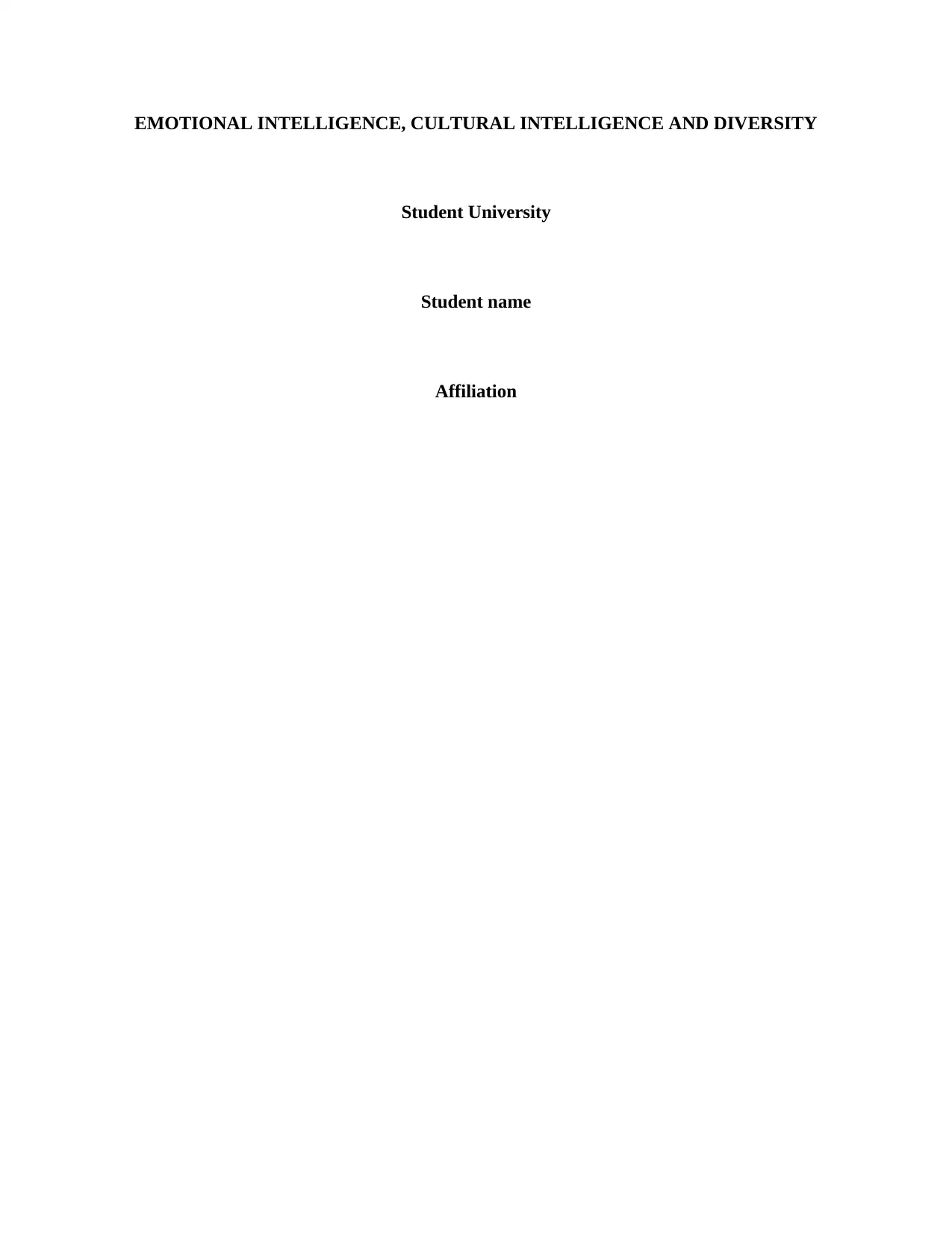
EMOTIONAL INTELLIGENCE, CULTURAL INTELLIGENCE AND DIVERSITY
Student University
Student name
Affiliation
Student University
Student name
Affiliation
Paraphrase This Document
Need a fresh take? Get an instant paraphrase of this document with our AI Paraphraser
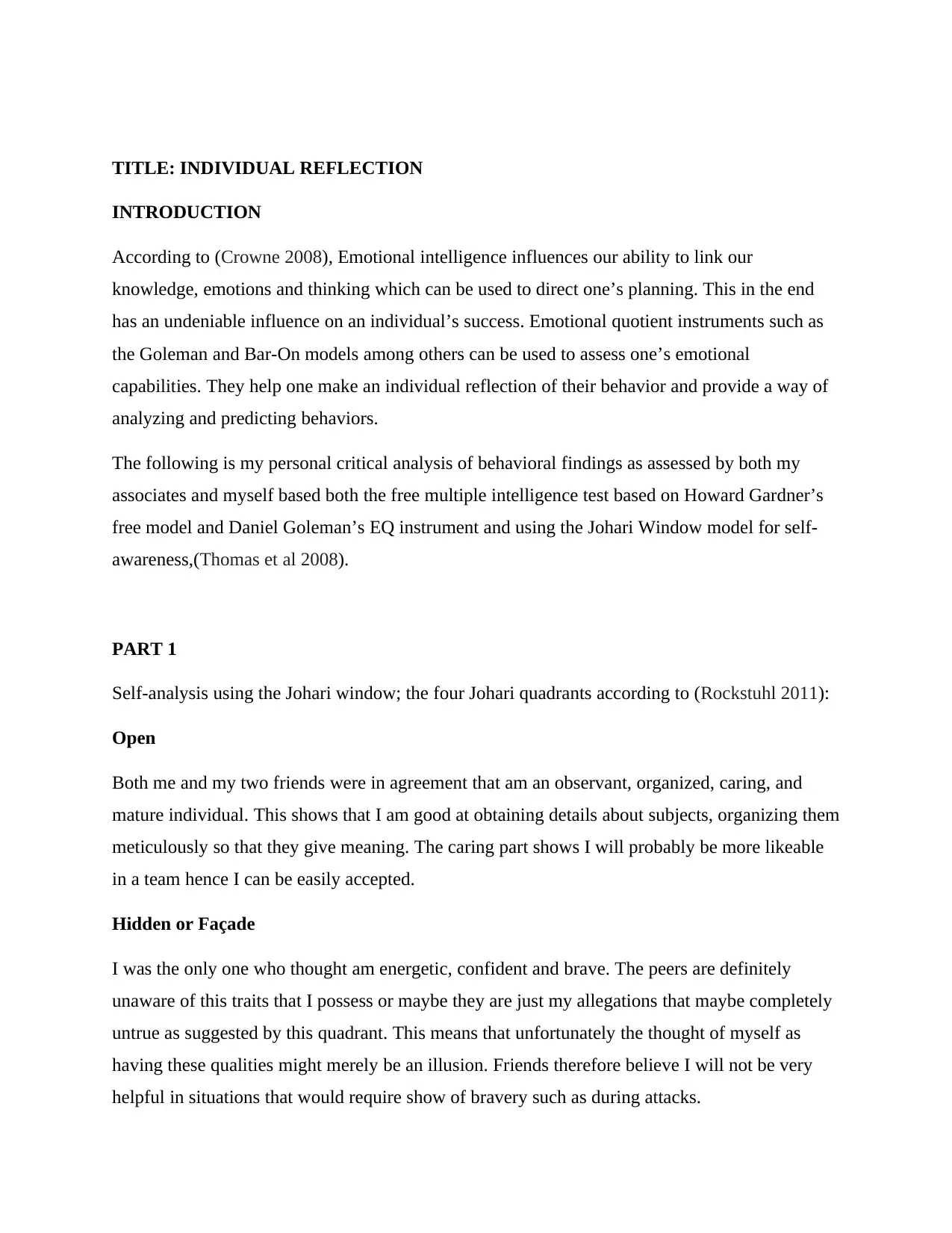
TITLE: INDIVIDUAL REFLECTION
INTRODUCTION
According to (Crowne 2008), Emotional intelligence influences our ability to link our
knowledge, emotions and thinking which can be used to direct one’s planning. This in the end
has an undeniable influence on an individual’s success. Emotional quotient instruments such as
the Goleman and Bar-On models among others can be used to assess one’s emotional
capabilities. They help one make an individual reflection of their behavior and provide a way of
analyzing and predicting behaviors.
The following is my personal critical analysis of behavioral findings as assessed by both my
associates and myself based both the free multiple intelligence test based on Howard Gardner’s
free model and Daniel Goleman’s EQ instrument and using the Johari Window model for self-
awareness,(Thomas et al 2008).
PART 1
Self-analysis using the Johari window; the four Johari quadrants according to (Rockstuhl 2011):
Open
Both me and my two friends were in agreement that am an observant, organized, caring, and
mature individual. This shows that I am good at obtaining details about subjects, organizing them
meticulously so that they give meaning. The caring part shows I will probably be more likeable
in a team hence I can be easily accepted.
Hidden or Façade
I was the only one who thought am energetic, confident and brave. The peers are definitely
unaware of this traits that I possess or maybe they are just my allegations that maybe completely
untrue as suggested by this quadrant. This means that unfortunately the thought of myself as
having these qualities might merely be an illusion. Friends therefore believe I will not be very
helpful in situations that would require show of bravery such as during attacks.
INTRODUCTION
According to (Crowne 2008), Emotional intelligence influences our ability to link our
knowledge, emotions and thinking which can be used to direct one’s planning. This in the end
has an undeniable influence on an individual’s success. Emotional quotient instruments such as
the Goleman and Bar-On models among others can be used to assess one’s emotional
capabilities. They help one make an individual reflection of their behavior and provide a way of
analyzing and predicting behaviors.
The following is my personal critical analysis of behavioral findings as assessed by both my
associates and myself based both the free multiple intelligence test based on Howard Gardner’s
free model and Daniel Goleman’s EQ instrument and using the Johari Window model for self-
awareness,(Thomas et al 2008).
PART 1
Self-analysis using the Johari window; the four Johari quadrants according to (Rockstuhl 2011):
Open
Both me and my two friends were in agreement that am an observant, organized, caring, and
mature individual. This shows that I am good at obtaining details about subjects, organizing them
meticulously so that they give meaning. The caring part shows I will probably be more likeable
in a team hence I can be easily accepted.
Hidden or Façade
I was the only one who thought am energetic, confident and brave. The peers are definitely
unaware of this traits that I possess or maybe they are just my allegations that maybe completely
untrue as suggested by this quadrant. This means that unfortunately the thought of myself as
having these qualities might merely be an illusion. Friends therefore believe I will not be very
helpful in situations that would require show of bravery such as during attacks.
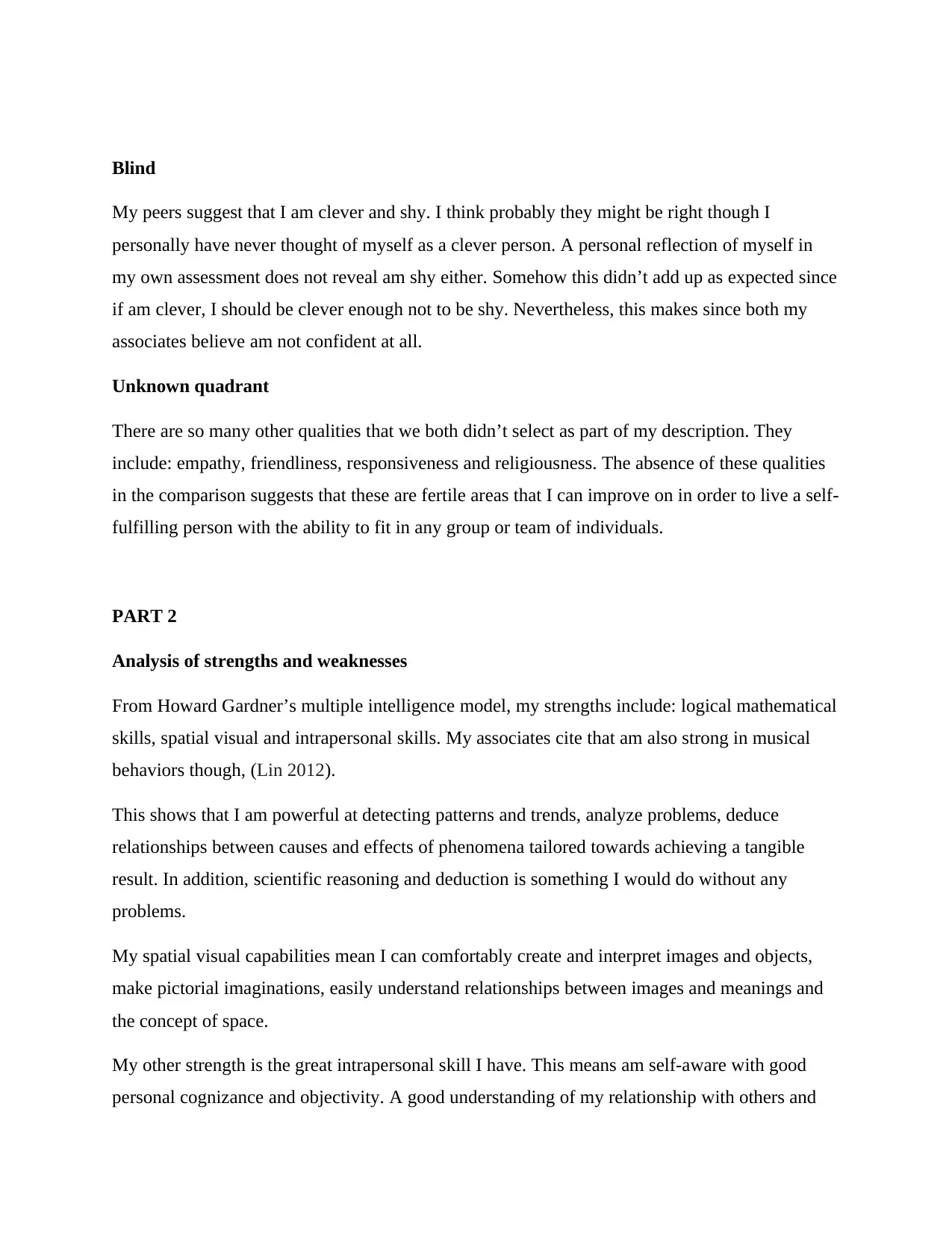
Blind
My peers suggest that I am clever and shy. I think probably they might be right though I
personally have never thought of myself as a clever person. A personal reflection of myself in
my own assessment does not reveal am shy either. Somehow this didn’t add up as expected since
if am clever, I should be clever enough not to be shy. Nevertheless, this makes since both my
associates believe am not confident at all.
Unknown quadrant
There are so many other qualities that we both didn’t select as part of my description. They
include: empathy, friendliness, responsiveness and religiousness. The absence of these qualities
in the comparison suggests that these are fertile areas that I can improve on in order to live a self-
fulfilling person with the ability to fit in any group or team of individuals.
PART 2
Analysis of strengths and weaknesses
From Howard Gardner’s multiple intelligence model, my strengths include: logical mathematical
skills, spatial visual and intrapersonal skills. My associates cite that am also strong in musical
behaviors though, (Lin 2012).
This shows that I am powerful at detecting patterns and trends, analyze problems, deduce
relationships between causes and effects of phenomena tailored towards achieving a tangible
result. In addition, scientific reasoning and deduction is something I would do without any
problems.
My spatial visual capabilities mean I can comfortably create and interpret images and objects,
make pictorial imaginations, easily understand relationships between images and meanings and
the concept of space.
My other strength is the great intrapersonal skill I have. This means am self-aware with good
personal cognizance and objectivity. A good understanding of my relationship with others and
My peers suggest that I am clever and shy. I think probably they might be right though I
personally have never thought of myself as a clever person. A personal reflection of myself in
my own assessment does not reveal am shy either. Somehow this didn’t add up as expected since
if am clever, I should be clever enough not to be shy. Nevertheless, this makes since both my
associates believe am not confident at all.
Unknown quadrant
There are so many other qualities that we both didn’t select as part of my description. They
include: empathy, friendliness, responsiveness and religiousness. The absence of these qualities
in the comparison suggests that these are fertile areas that I can improve on in order to live a self-
fulfilling person with the ability to fit in any group or team of individuals.
PART 2
Analysis of strengths and weaknesses
From Howard Gardner’s multiple intelligence model, my strengths include: logical mathematical
skills, spatial visual and intrapersonal skills. My associates cite that am also strong in musical
behaviors though, (Lin 2012).
This shows that I am powerful at detecting patterns and trends, analyze problems, deduce
relationships between causes and effects of phenomena tailored towards achieving a tangible
result. In addition, scientific reasoning and deduction is something I would do without any
problems.
My spatial visual capabilities mean I can comfortably create and interpret images and objects,
make pictorial imaginations, easily understand relationships between images and meanings and
the concept of space.
My other strength is the great intrapersonal skill I have. This means am self-aware with good
personal cognizance and objectivity. A good understanding of my relationship with others and
⊘ This is a preview!⊘
Do you want full access?
Subscribe today to unlock all pages.

Trusted by 1+ million students worldwide
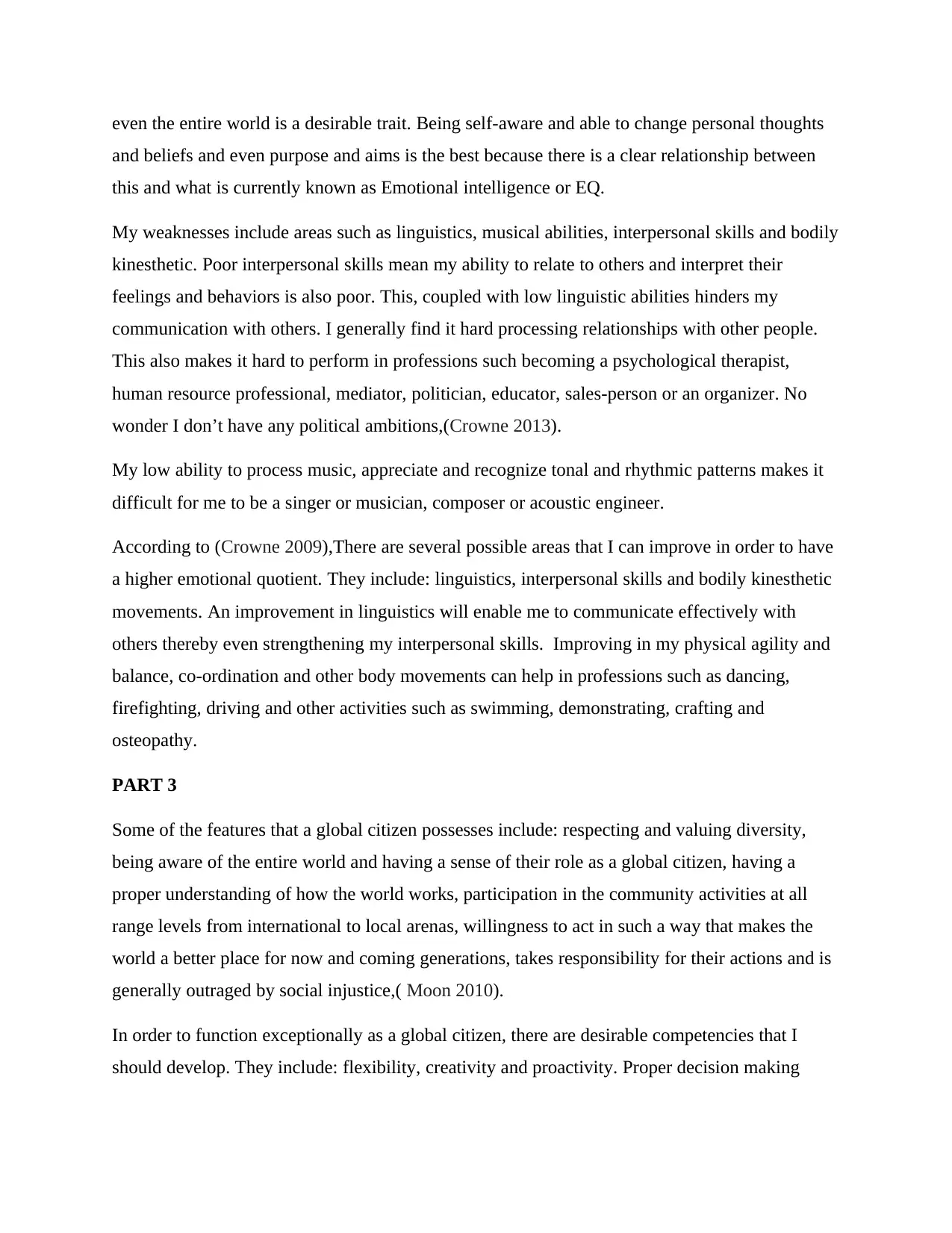
even the entire world is a desirable trait. Being self-aware and able to change personal thoughts
and beliefs and even purpose and aims is the best because there is a clear relationship between
this and what is currently known as Emotional intelligence or EQ.
My weaknesses include areas such as linguistics, musical abilities, interpersonal skills and bodily
kinesthetic. Poor interpersonal skills mean my ability to relate to others and interpret their
feelings and behaviors is also poor. This, coupled with low linguistic abilities hinders my
communication with others. I generally find it hard processing relationships with other people.
This also makes it hard to perform in professions such becoming a psychological therapist,
human resource professional, mediator, politician, educator, sales-person or an organizer. No
wonder I don’t have any political ambitions,(Crowne 2013).
My low ability to process music, appreciate and recognize tonal and rhythmic patterns makes it
difficult for me to be a singer or musician, composer or acoustic engineer.
According to (Crowne 2009),There are several possible areas that I can improve in order to have
a higher emotional quotient. They include: linguistics, interpersonal skills and bodily kinesthetic
movements. An improvement in linguistics will enable me to communicate effectively with
others thereby even strengthening my interpersonal skills. Improving in my physical agility and
balance, co-ordination and other body movements can help in professions such as dancing,
firefighting, driving and other activities such as swimming, demonstrating, crafting and
osteopathy.
PART 3
Some of the features that a global citizen possesses include: respecting and valuing diversity,
being aware of the entire world and having a sense of their role as a global citizen, having a
proper understanding of how the world works, participation in the community activities at all
range levels from international to local arenas, willingness to act in such a way that makes the
world a better place for now and coming generations, takes responsibility for their actions and is
generally outraged by social injustice,( Moon 2010).
In order to function exceptionally as a global citizen, there are desirable competencies that I
should develop. They include: flexibility, creativity and proactivity. Proper decision making
and beliefs and even purpose and aims is the best because there is a clear relationship between
this and what is currently known as Emotional intelligence or EQ.
My weaknesses include areas such as linguistics, musical abilities, interpersonal skills and bodily
kinesthetic. Poor interpersonal skills mean my ability to relate to others and interpret their
feelings and behaviors is also poor. This, coupled with low linguistic abilities hinders my
communication with others. I generally find it hard processing relationships with other people.
This also makes it hard to perform in professions such becoming a psychological therapist,
human resource professional, mediator, politician, educator, sales-person or an organizer. No
wonder I don’t have any political ambitions,(Crowne 2013).
My low ability to process music, appreciate and recognize tonal and rhythmic patterns makes it
difficult for me to be a singer or musician, composer or acoustic engineer.
According to (Crowne 2009),There are several possible areas that I can improve in order to have
a higher emotional quotient. They include: linguistics, interpersonal skills and bodily kinesthetic
movements. An improvement in linguistics will enable me to communicate effectively with
others thereby even strengthening my interpersonal skills. Improving in my physical agility and
balance, co-ordination and other body movements can help in professions such as dancing,
firefighting, driving and other activities such as swimming, demonstrating, crafting and
osteopathy.
PART 3
Some of the features that a global citizen possesses include: respecting and valuing diversity,
being aware of the entire world and having a sense of their role as a global citizen, having a
proper understanding of how the world works, participation in the community activities at all
range levels from international to local arenas, willingness to act in such a way that makes the
world a better place for now and coming generations, takes responsibility for their actions and is
generally outraged by social injustice,( Moon 2010).
In order to function exceptionally as a global citizen, there are desirable competencies that I
should develop. They include: flexibility, creativity and proactivity. Proper decision making
Paraphrase This Document
Need a fresh take? Get an instant paraphrase of this document with our AI Paraphraser
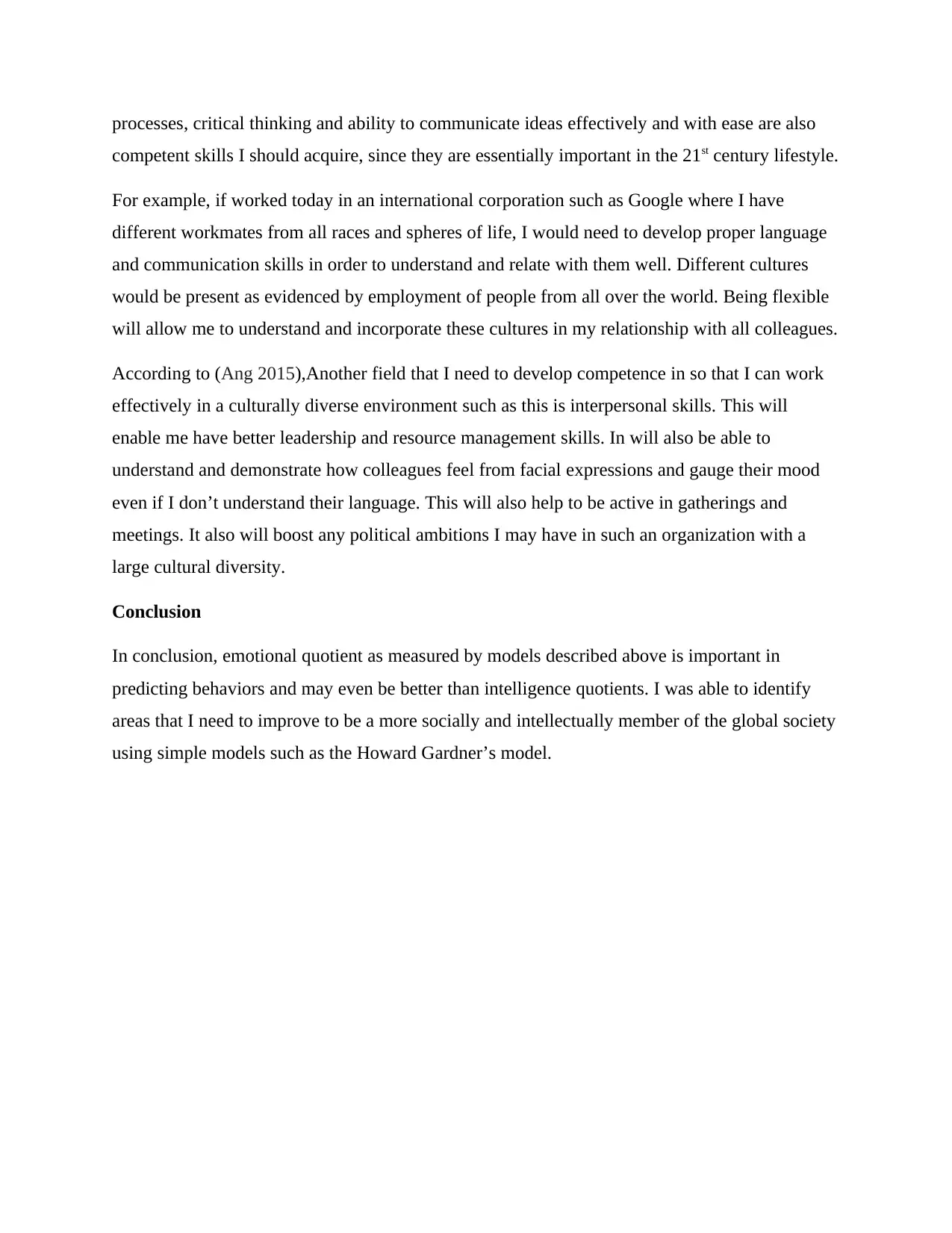
processes, critical thinking and ability to communicate ideas effectively and with ease are also
competent skills I should acquire, since they are essentially important in the 21st century lifestyle.
For example, if worked today in an international corporation such as Google where I have
different workmates from all races and spheres of life, I would need to develop proper language
and communication skills in order to understand and relate with them well. Different cultures
would be present as evidenced by employment of people from all over the world. Being flexible
will allow me to understand and incorporate these cultures in my relationship with all colleagues.
According to (Ang 2015),Another field that I need to develop competence in so that I can work
effectively in a culturally diverse environment such as this is interpersonal skills. This will
enable me have better leadership and resource management skills. In will also be able to
understand and demonstrate how colleagues feel from facial expressions and gauge their mood
even if I don’t understand their language. This will also help to be active in gatherings and
meetings. It also will boost any political ambitions I may have in such an organization with a
large cultural diversity.
Conclusion
In conclusion, emotional quotient as measured by models described above is important in
predicting behaviors and may even be better than intelligence quotients. I was able to identify
areas that I need to improve to be a more socially and intellectually member of the global society
using simple models such as the Howard Gardner’s model.
competent skills I should acquire, since they are essentially important in the 21st century lifestyle.
For example, if worked today in an international corporation such as Google where I have
different workmates from all races and spheres of life, I would need to develop proper language
and communication skills in order to understand and relate with them well. Different cultures
would be present as evidenced by employment of people from all over the world. Being flexible
will allow me to understand and incorporate these cultures in my relationship with all colleagues.
According to (Ang 2015),Another field that I need to develop competence in so that I can work
effectively in a culturally diverse environment such as this is interpersonal skills. This will
enable me have better leadership and resource management skills. In will also be able to
understand and demonstrate how colleagues feel from facial expressions and gauge their mood
even if I don’t understand their language. This will also help to be active in gatherings and
meetings. It also will boost any political ambitions I may have in such an organization with a
large cultural diversity.
Conclusion
In conclusion, emotional quotient as measured by models described above is important in
predicting behaviors and may even be better than intelligence quotients. I was able to identify
areas that I need to improve to be a more socially and intellectually member of the global society
using simple models such as the Howard Gardner’s model.

References
Ang, S. and Van Dyne, L., 2015. Handbook of cultural intelligence. Routledge.
Ang, S. and Van Dyne, L., 2015. Conceptualization of cultural intelligence: Definition,
distinctiveness, and nomological network. In Handbook of cultural intelligence (pp. 21-33).
Routledge.
Crowne, K.A., 2008. What leads to cultural intelligence?. Business Horizons, 51(5), pp.391-399.
Crowne, K.A., 2009. The relationships among social intelligence, emotional intelligence and
cultural intelligence. Organization Management Journal, 6(3), pp.148-163.
Crowne, K.A., 2013. Cultural exposure, emotional intelligence, and cultural intelligence: An
exploratory study. International Journal of Cross Cultural Management, 13(1), pp.5-22.
Moon, T., 2010. Emotional intelligence correlates of the four-factor model of cultural
intelligence. Journal of Managerial Psychology, 25(8), pp.876-898.
Rockstuhl, T., Seiler, S., Ang, S., Van Dyne, L. and Annen, H., 2011. Beyond general
intelligence (IQ) and emotional intelligence (EQ): The role of cultural intelligence (CQ) on
cross‐border leadership effectiveness in a globalized world. Journal of Social Issues, 67(4),
pp.825-840.
Thomas, D.C., Elron, E., Stahl, G., Ekelund, B.Z., Ravlin, E.C., Cerdin, J.L., Poelmans, S.,
Brislin, R., Pekerti, A., Aycan, Z. and Maznevski, M., 2008. Cultural intelligence: Domain and
assessment. International Journal of Cross Cultural Management, 8(2), pp.123-143.
Lin, Y.C., Chen, A.S.Y. and Song, Y.C., 2012. Does your intelligence help to survive in a
foreign jungle? The effects of cultural intelligence and emotional intelligence on cross-cultural
adjustment. International Journal of Intercultural Relations, 36(4), pp.541-552.
Ang, S. and Van Dyne, L., 2015. Handbook of cultural intelligence. Routledge.
Ang, S. and Van Dyne, L., 2015. Conceptualization of cultural intelligence: Definition,
distinctiveness, and nomological network. In Handbook of cultural intelligence (pp. 21-33).
Routledge.
Crowne, K.A., 2008. What leads to cultural intelligence?. Business Horizons, 51(5), pp.391-399.
Crowne, K.A., 2009. The relationships among social intelligence, emotional intelligence and
cultural intelligence. Organization Management Journal, 6(3), pp.148-163.
Crowne, K.A., 2013. Cultural exposure, emotional intelligence, and cultural intelligence: An
exploratory study. International Journal of Cross Cultural Management, 13(1), pp.5-22.
Moon, T., 2010. Emotional intelligence correlates of the four-factor model of cultural
intelligence. Journal of Managerial Psychology, 25(8), pp.876-898.
Rockstuhl, T., Seiler, S., Ang, S., Van Dyne, L. and Annen, H., 2011. Beyond general
intelligence (IQ) and emotional intelligence (EQ): The role of cultural intelligence (CQ) on
cross‐border leadership effectiveness in a globalized world. Journal of Social Issues, 67(4),
pp.825-840.
Thomas, D.C., Elron, E., Stahl, G., Ekelund, B.Z., Ravlin, E.C., Cerdin, J.L., Poelmans, S.,
Brislin, R., Pekerti, A., Aycan, Z. and Maznevski, M., 2008. Cultural intelligence: Domain and
assessment. International Journal of Cross Cultural Management, 8(2), pp.123-143.
Lin, Y.C., Chen, A.S.Y. and Song, Y.C., 2012. Does your intelligence help to survive in a
foreign jungle? The effects of cultural intelligence and emotional intelligence on cross-cultural
adjustment. International Journal of Intercultural Relations, 36(4), pp.541-552.
⊘ This is a preview!⊘
Do you want full access?
Subscribe today to unlock all pages.

Trusted by 1+ million students worldwide

1 out of 7
Related Documents
Your All-in-One AI-Powered Toolkit for Academic Success.
+13062052269
info@desklib.com
Available 24*7 on WhatsApp / Email
![[object Object]](/_next/static/media/star-bottom.7253800d.svg)
Unlock your academic potential
Copyright © 2020–2025 A2Z Services. All Rights Reserved. Developed and managed by ZUCOL.




